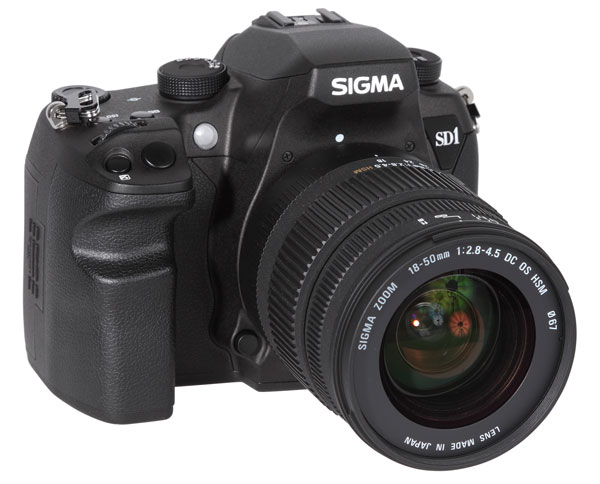Sigma SD1 DSLR Review

The SD1 is Sigma’s new flagship SLR system. It uses a brand new sensor with Foveon technology and a nominal resolution of 14.8 MP. This means that the camera is able to record RGB information for every single pixel. Standard digital cameras use sensors with the “classic” Bayer pattern, which means that every single pixel detects only one color information (red, green or blue) and then must undergo color interpolation.

The camera has a massive body. The right hand side grip is a bit small, however, compared to similar sized cameras among competitors. Nevertheless, the overall size is complemented by the camera’s large mode dials on the top. The left dial is used as power switch and for selecting shooting modes like single shot, continuous shooting or self-timer mode. The dial on the right hand side offers the standard exposure modes P, S, A and M. In addition, the camera offers three custom settings that are defined by setting up the camera with the desired parameters and saving them as C1 to C3 settings in the LCD menu.

The 3-inch LCD has a standard resolution of 460.000 RGB dots, which isn’t acceptable for a camera in this price range. The SD1 can’t be used in live preview mode; the LCD is used solely for the menu and for image review.

There are numerous dedicated function elements that help to setup the camera very quickly and easily. By pressing the “QS” mode the camera will show the first direct menu for setting up ISO speed or exposure mode (spot, matrix, center weighted). Pressing the QS button allows setup of resolution, image mode (JPEG, raw, raw + JPEG) and more. Other parameters are changed by pressing the four buttons on the standard cursor field.
The photographer can use two setup dials to change images parameters while shooting. The front dial near the shutter release button changes the aperture, the dial on back side of the top (which can be reached with the right thumb) allows for changing of shutter speed. Both dials are also activated when changing menu parameters.

The camera requires what we consider a lot of time to save images in raw mode. During our tests we used fast SanDisk Extreme CompactFlash cards. With this card the camera needs 10 to 12 seconds to save a single raw file. The buffers size allows the photographer to take up to 7 images (same in burst mode with 5.5 images per second) and after that the camera will start to save the images on the CF card.
Comments on Image Quality:
The camera showed very natural looking images, although with an overcautious saturation. The test chart was reproduced with only 81.16 percent, but the resulting chart (see below) proves that the color errors are mainly based on this saturation. The colors shows a direction into the center area of the chart which means that they are desaturated, but show basically the right color nuance. The automatic white balance system tends towards very cool nuances, which is also visible in the portrait test shot. Only red colors are a little over emphasized. When taking images in raw mode the camera shows very precise color reproduction.

The camera displayed a remarkably performance in our resolution tests. The test chart was reproduced with 2936 lines per picture height, which is an excellent result for a camera with a nominal resolution of 3.136 lines per picture height. Maybe even more important is the extremely high quality of the data. There are absolutely no image moirés noticeable and all details look very clear and crisp.

Take a look at the metal sieve in the upper left of the standard test box shot, which is reproduced in every single detail. There are only minor chromatic aberrations visible. The camera yields very fine details, especially when shooting in raw mode. Using these images, interpolations up to 200 percent are possible and still show really good results. We did printing tests with those interpolated images and achieved a resolution of 9408 x 6277 pixels.
Even though the camera has a nominal image resolution of 14.8 MP, its images really deserve Sigma’s “46 MP” label.

While the sharpness and resolution results are on a very high level, the results in the noise and dynamic range tests are only on a good level in lower ISO speed settings and unacceptable in the highest ISO ranges. The camera showed good results in images taken with ISO100 to 800, but noise will increase in an extreme way in images taken with ISO 3200 and 6400. While the luminance noise factor is on an average level (between 0.51 and 1.82) it rises considerably at ISO 3200.
The camera is able to shoot at up to ISO 6400, but showed some strange effects in the highest ISO mode. When making tests we take noise and dynamic range shots in manual camera mode, which means we are shooting with a fixed aperture and changing shutter speed to compensate for the rising ISO speed. For example: The first shot is done with ISO 100 setting and 1/80 s and f/8. The next shot is done with ISO 200 and 1/160s, f/8, and so on.
Using this technique we got standard image results with the Sigma SD1. However, when taking the shot at ISO 3200 the image was remarkably darker, even though the shutter setting was only half the speed compared to the previous shot with ISO 1600. When we did the shot with ISO 6400 the image got even darker and very noisy, even “grainy.” Color noise is clearly visible in images taken with ISO 1600 and higher, images taken with ISO 3200 couldn’t be reproduced in an acceptable way.
Pro:
+ Excellent crisp and clear, richly detailed images.
+ Very good handling system (two mode dials, two setup dials and many function buttons)
Con:
- Very long time required for processing and saving raw images (55 MB per image)
- Very high noise results in higher ISO speed settings (higher than ISO 1600)
- No live preview on LCD screen, no video capabilities
This review was created using data and opinions of Betternet, the testing lab we work with in our association with TIPA.

















































